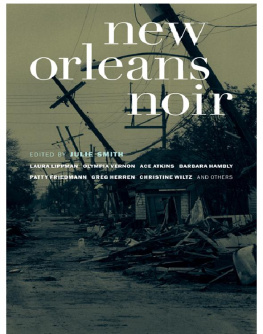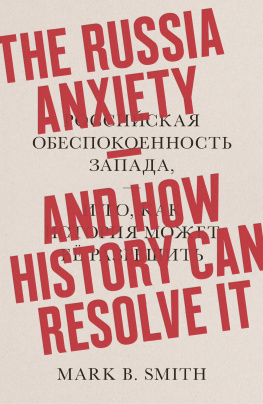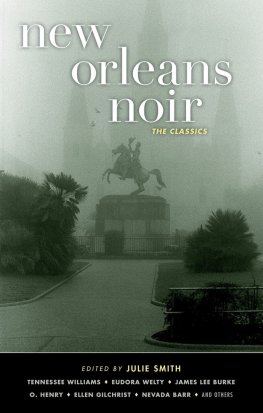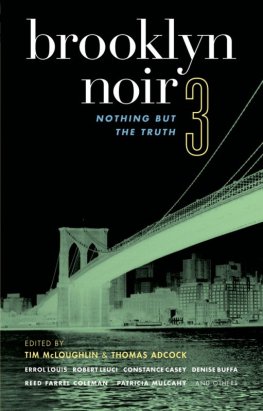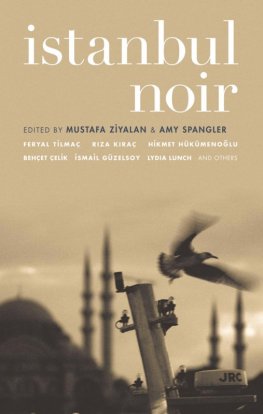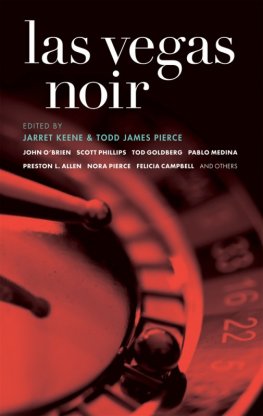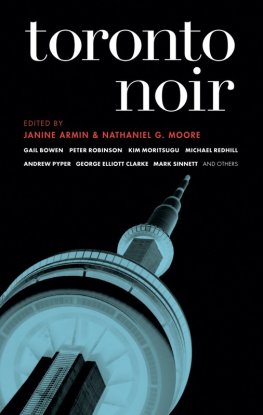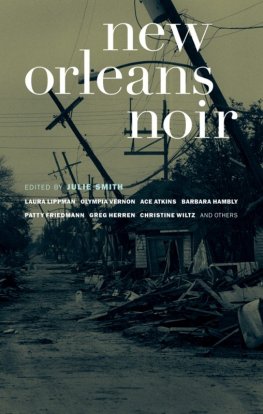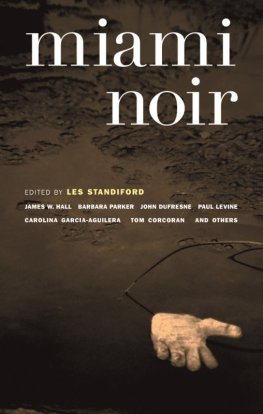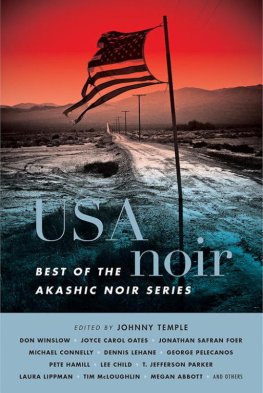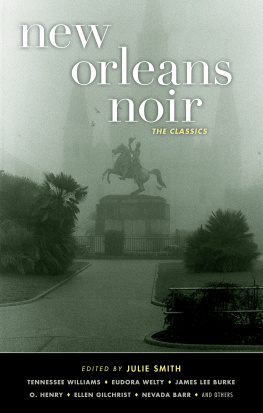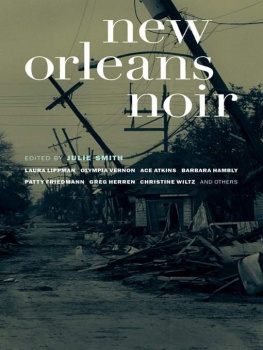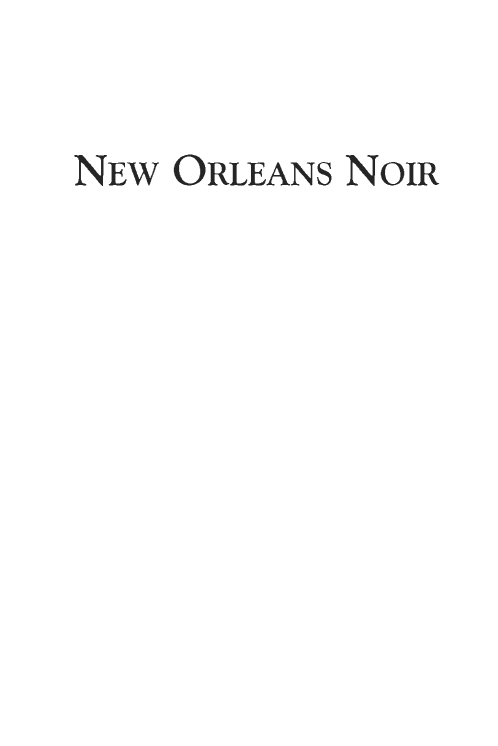
This collection is comprised of works of fiction. All names, characters, places, and incidents are the product of the authors imaginations. Any resemblance to real events or persons, living or dead, is entirely coincidental.
Published by Akashic Books
2007 Julie Smith
Series concept by Tim McLoughlin and Johnny Temple
New Orleans map by Sohrab Habibion
Cover photograph 2006 David G. Spielman, from his book Katrinaville Chronicles: Images and Observations from a New Orleans Photographer.
ePUB ISBN-13: 978-1-936-07039-8
ISBN-13: 978-1-933354-24-8
ISBN-10: 1-933354-24-0
Library of Congress Control Number: 2006938151
All rights reserved
Akashic Books
PO Box 1456
New York, NY 10009
info@akashicbooks.com
www.akashicbooks.com
ALSO IN THE AKASHIC NOIR SERIES:
Baltimore Noir, edited by Laura Lippman
Brooklyn Noir, edited by Tim McLoughlin
Brooklyn Noir 2: The Classics, edited by Tim McLoughlin
Chicago Noir, edited by Neal Pollack
D.C. Noir, edited by George Pelecanos
Dublin Noir, edited by Ken Bruen
London Noir, edited by Cathi Unsworth
Manhattan Noir, edited by Lawrence Block
Miami Noir, edited by Les Standiford
San Francisco Noir, edited by Peter Maravelis
Twin Cities Noir, edited by Julie Schaper & Steven Horwitz
FORTHCOMING:
Bronx Noir, edited by S.J. Rozan
Detroit Noir, edited by Eric Olsen & Chris Hocking
Havana Noir (Cuba), edited by Achy Obejas
Lagos Noir (Nigeria), edited by Chris Abani
Los Angeles Noir, edited by Denise Hamilton
Paris Noir (France), edited by Aurlien Masson
Queens Noir, edited by Robert Knightly
Rome Noir (Italy), edited by Chiara Stangalino & Maxim Jakubowski
Wall Street Noir, edited by Peter Spiegelman
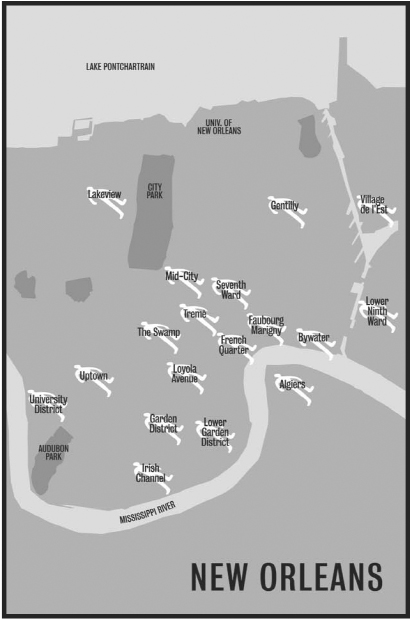
To those who took care of us:
Janet and Steve Haedicke, the first week;
Kiley, Molly, and Tory McGuire, the next month;
and Debra Allen, who saved the cats
Acknowledgments
Thanks have to begin with Tim McLoughlin, who started the Akashic Noir Series with Brooklyn Noir, and Johnny Temple, whos turned it into a cultural phenomenon; and then move quickly to the seventeen brilliant authors who agreed to participate in this one. Working with all of you has been a joy.
And so many others helped in so many ways: Laura Lippman, Vicky Bijur, David Simon, Denelle Cowart, Chris Wiltz, Greg Herren, David Spielman, Linda Buczek, Jack Willoughby, Captain Jeff Winn, Paul Willis of the Tennessee Williams Festival, Ron Biava of the New Orleans Public Library, Lee Pryor, and especially Mary Alice Kier and Anna Cottle, who put some serious time in, just as a favor. My most heartfelt thanks to all. Plus a second thank you to Johnny Temple for so generously sharing in our recovery.
B efore Hurricane Katrina, New Orleanians used to joke about not really being a part of America, being, in fact, a tiny Third World country unto ourselves. And proud of it, we used to say.
The layers of irony in that idea become clearerand more numerouswith each day that passes since our city was inundated and, well pretty much leveled, except for the skinny strip along the river where were all hunkered now. (At least those of us who arent still trying to get home from Houston or havent packed up and moved to North Carolina.)
The Bubble, we call it, or the Isle of Denial, but some days the denial just doesnt work and neither does the Prozac, and we get all liquid in the eyeballs and have to pull ourselves together.
Little more than a year after the storm, were still floundering, still in shock, still wondering how to write about such a momentous, life-changing, historic, downright biblical tragedy. Weve lost so much that meant so much, and were struggling so desperately to hold onto what is left. How to convey something like that?
Last Christmas, when we were all just barely home, just starting to get our bearings, a librarian at Tulane University told me shed already bought twenty-five post-Katrina books for her library. Nonfiction? I asked.
Of course, she said.
She must be up to a hundred by now, but so far as I know, only one post-K novel has been published at this writing. Though I have no doubt hundreds are in the works Everyone is struggling to find a way to tell his or her story, to tell it in such a way that those who didnt go through this particular bewildering and disorienting loss can understand how it relates to the larger picture, how universal a thing it really is, this destruction and this potential for destruction, this aching misery, this indifference on the part of the rest of the country. Never have so many writers in such a small area become so passionate, yet so desperate, all at the same time. We are at once immobilized by the task and inflamed by it.
So a short story is really the perfect way to stick a toe back in the water. Whether set pre- or post-K (these are the terms we use down here), the stories herein, to my mind, are particularly passionate. Some of the post-K ones will sear your eyeballs. And yet so will some of the historic ones.
Patty Friedmanns tale of mean girls at an Uptown private school may well be the most chilling story ever set at a kids pajama party. The nineteenth-century yarn by Barbara Hambly and David Fulmers Algiers, set a century ago, provide ample evidence that, so far as crime is concerned in this French city, plus a change, plus cest la mme chose. Weve always had our con artists, our gamblers, our two-bit hustlers, and, God knows, our hookers and femmes fatales. Wed hardly be ourselves without them.
Alas, we also have our racists. Jervey Tervalon offers a peek into the discrimination of the past in his story of two wrangling priests, one a bigot and proud of it. Ted OBrien also tackles the issue of racewith all its tangles and contradictionsin a twenty-first-century mixed neighborhood.
James Nolans wry and wicked Open Mike leads us on a careening tour of the undersideboth past and presentof that gaudy world known as the French Quarter; the part the tourists havent a clue about. Laura Lippman treats us to an insiders look at the Trem Mardi Gras, one of the citys most colorful, while providing so hair-raising a take on masking that it ventures into horror territory.
Before reading Tim McLoughlins worldly-wise Irish Channel story, be sure to pour yourself a couple of fingers of Irish whiskey. Youll need itespecially if you next move on to Olympia Vernons unnerving tale of love gone wrong in the University District.
The Lower Ninth Ward, perhaps our most famous neighborhood of late, was always a tough place, but it had its tender side too, its neighborly, gentle, almost maternal side, the side that makes people so desperate to go back no matter whatno matter that it mostly doesnt even exist anymore. Kalamu ya Salaam skillfully evokes the complexity of its residents lives.
Not surprisingly, almost half the writers chose to make their stories contemporary. And its a good choice, I think. For this is what we live with nowthis is the new New Orleans. This messy, ugly, often violent, confusing, difficult, inconvenient, frustrating post-Katrina world.
In Muddy Pond, Maureen Tan wades into a part of the city most of its black and white citizens are only vaguely aware of, and almost never visitVillage de lEst in New Orleans East, where the church called Mary Queen of Vietnam is the dominant social organization. Unless you count the gangs.
Next page
